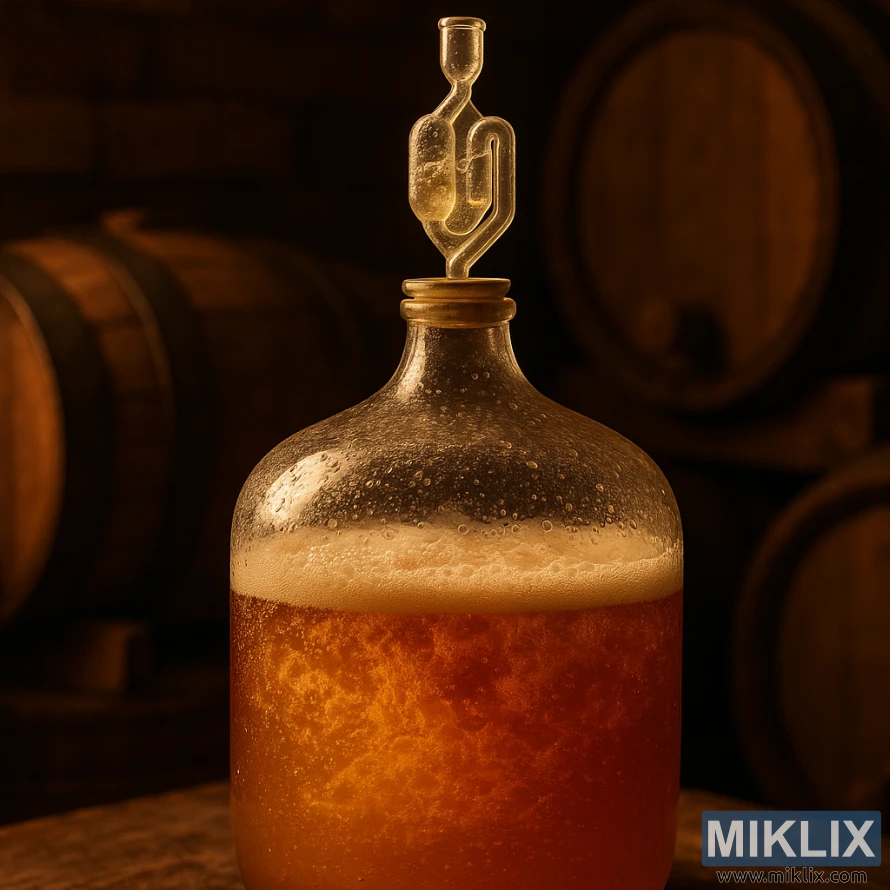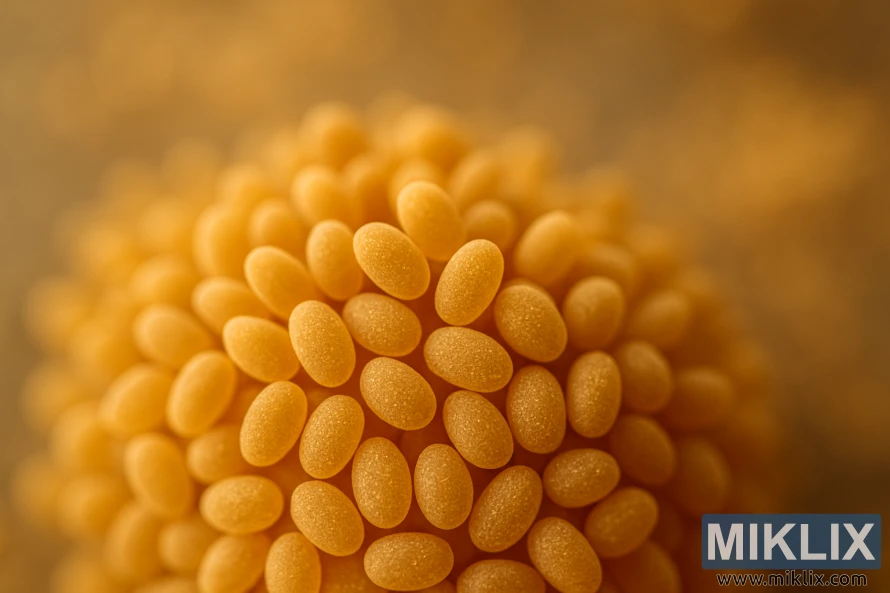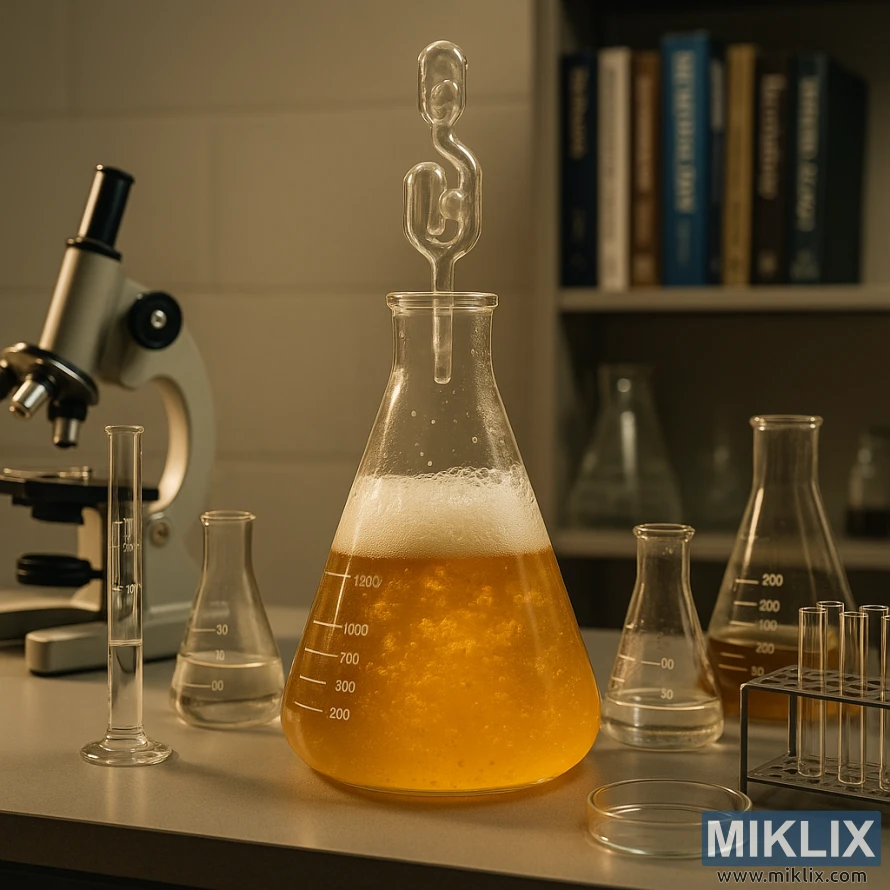Fermenting Beer with Lallemand LalBrew Belle Saison Yeast
Published: July 24, 2025 at 6:13:31 PM UTC
Beer fermentation is a critical process in brewing that requires the right yeast to produce the desired flavor and character. Lallemand LalBrew Belle Saison yeast is a popular choice among brewers for creating Belgian-style ales, including Saison-style beers. This yeast strain is selected for its ability to enhance brewing applications and produce complex flavors. Using the right saison yeast can significantly impact the fermentation process, resulting in a high-quality beer.

Key Takeaways
- Understanding the role of yeast in beer fermentation.
- Characteristics of Lallemand LalBrew Belle Saison yeast.
- Tips for optimal brewing applications.
- Benefits of using saison yeast for Belgian-style ales.
- Common challenges in beer fermentation and how to overcome them.
Introduction to Lallemand LalBrew Belle Saison
The Lallemand LalBrew Belle Saison yeast is crafted for brewing Saison-style beers. It's a diastaticus variant, allowing brewers to achieve high attenuation. This is a key characteristic of Saison beers.
This yeast is engineered to convert starches into fermentable sugars. This results in a dry finish, typical of Saison-style ales. Its ability to ferment at various temperatures makes it versatile for different brewing conditions.
Using Lallemand LalBrew Belle Saison offers several benefits. It produces complex flavors and tolerates different fermentation conditions. This makes it perfect for brewers experimenting with Saison-style beers or refining traditional recipes.
- Produces complex flavors typical of Saison-style beers
- Exhibits high attenuation for a dry finish
- Can ferment over a range of temperatures
Understanding Lallemand LalBrew Belle Saison yeast's characteristics helps brewers manage fermentation. This ensures the desired outcomes in their Saison beers.
Technical Specifications and Strain Information
The Lallemand LalBrew Belle Saison yeast is a specialized strain for brewing Saison beers. It's known for its high attenuation rate, averaging 82-83%. This contributes to a dry and crisp finish, a hallmark of Saison beers.
This yeast strain has a moderate to high flocculation rate. This is beneficial for brewers, leading to clear and stable beer. It reduces the need for additional clarification processes.
Key technical specifications of the Lallemand LalBrew Belle Saison yeast include:
- High attenuation rate: 82-83%
- Moderate to high flocculation rate
- Specialized strain for Saison beer production
These specifications make the Lallemand LalBrew Belle Saison yeast a top choice for brewers. They aim to produce authentic Saison beers with complex flavors and crisp finishes.
Understanding Saison Yeast Characteristics
Brewing Saison-style beers with Lallemand LalBrew Belle Saison yeast reveals its unique traits. This yeast is celebrated for crafting complex, refreshing beers.
The Lallemand LalBrew Belle Saison yeast is renowned for its fruity and spicy flavor profile. This contributes to the beer's refreshing quality. It's known for a dry, crisp taste with fruity and spicy notes, making it a top choice for Saison-style ales.
Its aroma is characterized by citrus and pepper, adding depth and complexity. This combination of flavors and aromas creates a well-rounded Saison beer.
Lallemand LalBrew Belle Saison's distinct yeast characteristics make it perfect for authentic Saison beers. Its fermentation performance and sensory contributions are key to its popularity.
Understanding this yeast's characteristics helps brewers enhance their beers. They can focus on the desirable fruity and spicy flavors and the refreshing dry finish it offers.

Optimal Fermentation Conditions
To maximize the benefits of Lallemand LalBrew Belle Saison yeast, brewers need to grasp the best fermentation conditions. This yeast excels in temperatures between 59-95°F (15-35°C). This range makes it adaptable for a wide range of brewing environments.
The pitching rate is another critical factor. For Lallemand LalBrew Belle Saison yeast, it should be between 1-2 million cells per milliliter. This rate is key to preventing off-flavors and ensuring a smooth fermentation process.
Keeping the fermentation vessel clean and sanitized is essential. Any contamination can introduce unwanted flavors and aromas, spoiling the batch. Proper sanitation of equipment is vital for a successful fermentation.
- Optimal temperature range: 59-95°F (15-35°C)
- Recommended pitching rate: 1-2 million cells/mL
- Importance of clean and sanitized equipment
Following these guidelines will help brewers achieve optimal fermentation. This leads to a top-notch Saison beer. The beer will highlight the unique traits of the Lallemand LalBrew Belle Saison yeast.
Temperature Range and Impact on Flavor
The temperature during fermentation is key in shaping the flavor of beers made with Lallemand LalBrew Belle Saison yeast. Temperatures above 75°F (24°C) lead to fruitier and more estery flavors. On the other hand, temperatures below 65°F (18°C) result in cleaner, more neutral tastes.
When brewing with Lallemand LalBrew Belle Saison yeast, temperature is critical. Even slight temperature changes can greatly affect the beer's taste. This yeast is very sensitive to temperature shifts.
To get the best flavor, brewers should aim for the optimal temperature range for Lallemand LalBrew Belle Saison yeast. By managing the fermentation temperature, brewers can control the formation of esters and other compounds. These elements are vital in shaping the beer's taste and aroma.
- Higher temperatures: fruitier and more estery flavor
- Lower temperatures: cleaner and more neutral flavor
- Optimal temperature range: between 65°F to 75°F (18°C to 24°C)
Understanding how temperature influences yeast performance helps brewers make better choices. This knowledge is essential for achieving the desired flavor in their beers.
Alcohol Tolerance and Attenuation Rates
Lallemand LalBrew Belle Saison yeast boasts high alcohol tolerance. This allows brewers to craft a broad spectrum of beers. From light session brews to robust imperial ales, the possibilities are endless.
Its high alcohol tolerance makes it perfect for brewing high-ABV beers. The yeast's average attenuation rate of 82-83% ensures efficient sugar consumption. This results in a balanced flavor profile, pleasing even the most discerning palates.
- High alcohol tolerance allows for brewing a variety of beer styles
- Average attenuation rate: 82-83%
- Consistent fermentation performance
Lallemand LalBrew Belle Saison yeast stands out due to its high alcohol tolerance and consistent attenuation rates. It's a go-to choice for brewers aiming to create complex, balanced beers. Its versatility makes it ideal for a wide range of brewing endeavors.

Preparing Your Yeast Starter
To ensure a vigorous fermentation, brewers must properly prepare a yeast starter for LalBrew Belle Saison. A yeast starter is a culture of yeast grown in a controlled environment before being added to the main fermentation vessel.
Preparing a yeast starter is essential. It allows the yeast to adapt to fermentation conditions, ensuring a healthy fermentation. This leads to faster and more complete fermentation, with cleaner and more complex flavors.
The process of creating a yeast starter involves rehydrating the Lallemand LalBrew Belle Saison yeast in a small amount of wort or starter medium. It's important to consider the ideal pitching rate and yeast propagation techniques for optimal results.
- Rehydrate the yeast in a suitable starter medium.
- Monitor the yeast starter's activity and health.
- Adjust the pitching rate according to the specific brew requirements.
By properly preparing a yeast starter, brewers can ensure a successful fermentation. This leads to the desired flavor and aroma characteristics in their Saison beer. Proper yeast propagation and pitching rates are critical for a healthy fermentation.
Brewing Process Modifications
To maximize the benefits of Lallemand LalBrew Belle Saison yeast, brewers should tweak their brewing methods. Adjustments in temperature and pitching rates are key. These changes can greatly affect fermentation and yeast performance.
Modifying the brewing process is essential for a healthy fermentation. For example, temperature adjustments can impact ester and flavor compound production. Incorrect temperatures can result in off-flavors or slow fermentation.
Pitching rates are also critical. Under-pitching can stress the yeast, leading to unwanted flavors. Over-pitching, on the other hand, can cause rapid fermentation, potentially reducing flavor complexity.
By refining these brewing parameters, brewers can craft a variety of beers. This includes everything from light session beers to robust imperial beers. All this is done while ensuring optimal fermentation and yeast performance.
Managing Fermentation Phases
To get the best results with Lallemand LalBrew Belle Saison yeast, brewers must manage fermentation phases carefully. They need to monitor and control various parameters. This ensures a healthy and vigorous fermentation process.
Effective management of fermentation phases is key to producing beers with complex and clean flavors. By controlling temperature and tracking specific gravity, brewers can greatly influence yeast performance. This, in turn, affects the beer's overall character.
Key aspects to focus on during fermentation include maintaining the optimal temperature range and monitoring the attenuation rates. Lallemand LalBrew Belle Saison yeast can ferment at a wide range of temperatures. But, it performs best within specific temperature limits.
By understanding and managing these factors, brewers can unlock the full capability of the Lallemand LalBrew Belle Saison yeast. This results in high-quality beers that meet their desired specifications.
- Monitor temperature and specific gravity regularly.
- Adjust fermentation parameters as needed to maintain optimal conditions.
- Understand the characteristics of Lallemand LalBrew Belle Saison yeast to optimize its performance.

Common Challenges and Solutions
To achieve optimal results with Lallemand LalBrew Belle Saison yeast, brewers must be aware of common challenges. They also need to know how to address them effectively.
When brewing with this yeast, brewers often face issues like under-pitching and over-pitching. These problems can lead to slow or incomplete fermentation. Under-pitching results in inadequate yeast growth. On the other hand, over-pitching can stress the yeast, potentially causing off-flavors.
To troubleshoot these issues, brewers can adjust the pitching rate and monitor fermentation parameters. This includes temperature and specific gravity. Maintaining optimal fermentation conditions is key for healthy yeast performance.
- Monitor and adjust pitching rates according to the specific gravity of the wort.
- Use yeast nutrients and other additives to promote a healthy and vigorous fermentation.
- Maintain optimal temperature ranges to support yeast activity.
By understanding these common challenges and implementing effective solutions, brewers can optimize their use of Lallemand LalBrew Belle Saison yeast. This way, they can produce high-quality Saison beers.
Recipe Development Guidelines
Creating a recipe with Lallemand LalBrew Belle Saison yeast demands a thorough grasp of its traits. These traits significantly influence the final beer's taste and quality. By tweaking recipe elements, brewers can fine-tune fermentation conditions. This allows for the creation of a broad spectrum of beer styles.
Optimal results in recipe development hinge on several critical factors. These include the grain mix, hop additions, and other ingredients. Each plays a role in yeast performance and fermentation outcomes.
Key considerations for recipe development with Lallemand LalBrew Belle Saison yeast include:
- Selecting a grain bill that complements the yeast's characteristics and promotes a healthy fermentation.
- Using hop additions that enhance the beer's flavor and aroma without inhibiting yeast performance.
- Adjusting the recipe to achieve the desired balance of flavor compounds and fermentation parameters.
By meticulously considering these factors and making necessary adjustments, brewers can fully harness Lallemand LalBrew Belle Saison yeast's capabilities. This results in high-quality beers that highlight its unique attributes.
Comparing Belle Saison to Other Saison Yeasts
Brewers aiming for a Saison with fruity and spicy notes might find Lallemand LalBrew Belle Saison appealing. This yeast stands out with its distinct flavor and aroma. It boasts a high attenuation rate and moderate to high flocculation rate.
Lallemand LalBrew Belle Saison presents a unique alternative to other Saison yeasts. Its flavor is more fruit-forward and spicy. It also offers a cleaner, more complex finish compared to some competitors.
When comparing Lallemand LalBrew Belle Saison to other Saison yeasts, several key differences emerge:
- Higher attenuation rate, resulting in a drier finish
- More pronounced fruit and spice flavors
- Moderate to high flocculation rate, affecting the clarity and character of the beer
These traits make Lallemand LalBrew Belle Saison a compelling choice for brewers. They seek to craft a Saison with a unique and complex flavor profile. By understanding these differences, brewers can make informed decisions for their brewing projects.
Commercial Brewing Applications
Lallemand LalBrew Belle Saison yeast is celebrated for its consistent performance in commercial brewing. It boasts a high attenuation rate and moderate to high flocculation rate. This makes it perfect for breweries aiming to craft high-quality Saison-style beers.
The yeast's ability to produce a dry and crisp finish, along with fruity and spicy flavors, is spot on for traditional Saison beers. It's a top pick for commercial breweries wanting to create authentic Saison-style beers. These beers are highly sought after by craft beer enthusiasts.
Commercial breweries gain from the yeast's consistent performance. This includes:
- High attenuation rates leading to a dry finish
- Moderate to high flocculation rates for easier yeast management
- Fruity and spicy flavor profiles typical of Saison beers
By utilizing Lallemand LalBrew Belle Saison yeast, commercial breweries can produce a variety of Saison-style beers. These beers meet the diverse tastes of consumers. Its dependability and performance are key assets in the competitive craft brewing world.
Quality Control and Storage Guidelines
To ensure the optimal performance of Lallemand LalBrew Belle Saison yeast, brewers must adhere to strict quality control and storage guidelines.
Proper storage and handling of the yeast are critical to maintaining its health and viability. This includes storing the yeast in a cool, dry place, away from direct sunlight and moisture.
Brewers should follow proper sanitation and handling procedures to prevent contamination and promote a healthy and vigorous fermentation.
- Store yeast in a cool, dry place.
- Keep yeast away from direct sunlight and moisture.
- Follow proper sanitation and handling procedures.
By prioritizing quality control and proper storage, brewers can ensure the consistent production of high-quality beers using Lallemand LalBrew Belle Saison yeast.
Conclusion
The Lallemand LalBrew Belle Saison yeast is a top-notch choice for brewing Saison-style beers. It boasts a high attenuation rate and moderate to high flocculation rate. This results in a dry and crisp finish, complemented by fruity and spicy flavors.
By adhering to proper brewing and fermentation methods, brewers can fully harness this yeast's capabilities. We suggest trying out various recipes and techniques to truly appreciate the Lallemand LalBrew Belle Saison yeast's attributes.
For those aiming to craft exceptional Saison beers, this yeast is a standout option. Its consistent quality and distinctive flavor profile make it a gem for any brewery. As you continue brewing with this yeast, we encourage you to experiment with new recipes and techniques to enhance your brewing process.
Further Reading
If you enjoyed this post, you may also like these suggestions:
- Fermenting Beer with Fermentis SafLager S-189 Yeast
- Fermenting Beer with Wyeast 1388 Belgian Strong Ale Yeast
- Fermenting Beer with CellarScience Baja Yeast
